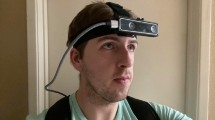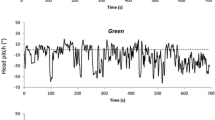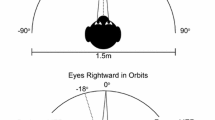Abstract
The tendency to generate head movements during saccades varies from person to person. Head movement tendencies can be measured as subjects fixate sequences of illuminated targets, but the extent to which such measures reflect eye–head coupling during more natural behaviors is unknown. We quantified head movement tendencies in 20 normal subjects in a conventional laboratory experiment and in an outdoor setting in which the subjects directed their gaze spontaneously. In the laboratory, head movement tendencies during centrifugal saccades could be described by the eye-only range (EOR), customary ocular motor range (COMR), and the customary head orientation range (CHOR). An analogous EOR, COMR, and CHOR could be extracted from the centrifugal saccades executed in the outdoor setting. An additional six measures were introduced to describe the preferred ranges of eyes-in-head and head-on-torso manifest throughout the outdoor recording, i.e., not limited to the orientations following centrifugal saccades. These 12 measured variables could be distilled by factor analysis to one indoor and six outdoor factors. The factors reflect separable tendencies related to preferred ranges of visual search, head eccentricity, and eye eccentricity. Multiple correlations were found between the indoor and outdoor factors. The results demonstrate that there are multiple types of head movement tendencies, but some of these influence behavior across rather different experimental settings and tasks. Thus behavior in the two settings likely relies on common neural mechanisms, and the laboratory assays of head movement tendencies succeed in probing the mechanisms underlying eye–head coupling during more natural behaviors.


Similar content being viewed by others
Notes
The original method of calculating COMR (Stahl 1999) was altered slightly to correspond with the method of calculating CHOR. In the original method, we generated a curve proportional to the frequency of final eye eccentricity and then adjusted for non-uniformity of the distribution of T H by dividing, point-by-point, by a curve proportional to the frequency of T H. The new technique, in which the kernel for each saccade is pre-scaled according to the frequency of that saccade’s T H, is more rigorously correct. The results of the two methods, however, are quite similar; for 35 measurements of COMR derived from 35 experimental sessions of 12 subjects, there was a strong linear relationship between the new and old measures, with a slope of 0.93 and a coefficient of determination (r 2) of 0.99.
References
Afanador A, Aitsebaono P (1982) The range of eye movements through progressive lenses. Optom Mon 73:127–135
Bard C, Fleury M, Paillard J (1992) Different patterns in aiming accuracy for head-movers and non-head movers. In: Berthoz A, Vidal PP, Graf W (eds) The head–neck sensory motor system. Oxford University Press, New York, pp 582–586
Chatterjee S, Price B (1977) Regression analysis by example. Wiley, New York
Cliff N (1987) Analyzing multivariate data. Harcourt Brace Jovanovich, New York
Draper NR, Smith H (1981) Applied regression analysis. Wiley, New York
Einhäuser W, Schumann F, Bardins S, Bartl K, Böning G, Schneider E, König P (2007) Human eye–head co-ordination in natural exploration. Network 18:267–297
Fuller JH (1992) Head movement propensity. Exp Brain Res 92:152–164
Fuller JH (1996) Comparison of horizontal head movements evoked by auditory and visual targets. J Vestib Res 6:1–13
Geruschat DR, Hassan SE, Turano KA (2003) Gaze behavior while crossing complex intersections. Optom Vis Sci 80:515–528
Goldring JE, Dorris MC, Corneil BD, Ballantyne PA, Munoz DP (1996) Combined eye–head gaze shifts to visual and auditory targets in humans. Exp Brain Res 111:68–78
Goossens H, Van Opstal A (1997) Human eye–head coordination in two dimensions under different sensorimotor conditions. Exp Brain Res 114:542–560
Hanes DA, McCollum G (2006) Variables contributing to the coordination of rapid eye/head gaze shifts. Biol Cybern 94:300–324
Herst AN, Epelboim J, Steinman RM (2001) Temporal coordination of the human head and eye during a natural sequential tapping task. Vision Res 41:3307–3319
Hollands M, Patla A, Vickers J (2002) “Look where you’re going!”: gaze behaviour associated with maintaining and changing the direction of locomotion. Exp Brain Res 143:221–230
Kowler E, Pizlo Z, Zhu G, Erkelens CJ, Steinman RM, Collewijn H (1992) Coordination of head and eyes during the performance of natural (and unnatural) visual tasks. In: Berthoz A, Graf W, Vidal PP (eds) The head–neck sensory motor system. Oxford University Press, Oxford
Land MF (1992) Predictable eye–head coordination during driving. Nature 359:318–320
Land M, Tatler B (2001) Steering with the head. the visual strategy of a racing driver. Curr Biol 11:1215–1220
Lee C (1999) Eye and head coordination in reading: roles of head movement and cognitive control. Vision Res 39:3761–3768
Oommen BS, Stahl JS (2005a) Amplitudes of head movements during putative eye-only saccades. Brain Res 1065:68–78
Oommen BS, Stahl JS (2005b) Inhibited head movements: a risk of combining phoning with other activities? Neurology 65:754–756
Oommen BS, Stahl JS (2005c) Overlapping gaze shifts reveal timing of an eye–head gate. Exp Brain Res 167:276–286
Oommen BS, Smith RM, Stahl JS (2004) The influence of future gaze orientation upon eye–head coupling during saccades. Exp Brain Res 155:9–18
Pelz J, Hayhoe M, Loeber R (2001) The coordination of eye, head, and hand movements in a natural task. Exp Brain Res 139:266–277
Proudlock F, Shekhar H, Gottlob I (2003) Coordination of eye and head movements during reading. Invest Ophthalmol Vis Sci 44:2991–2998
Silverman BW (1986) Density estimation for statistics and data analysis. Chapman and Hall, New York
Smeets J, Hayhoe M, Ballard D (1996) Goal-directed arm movements change eye–head coordination. Exp Brain Res 109:434–440
Stahl JS (1999) Amplitude of human head movements associated with horizontal saccades. Exp Brain Res 126:41–54
Stahl JS (2001) Adaptive plasticity of head movement propensity. Exp Brain Res 139:201–208
Thumser ZC, Stahl JS (2008) Laboratory measures of eye–head coupling predict spontaneous behavior in natural environment. Soc Neurosci Abstr 34
Volle M, Guitton D (1993) Human gaze shifts in which head and eyes are not initially aligned. Exp Brain Res 94:463–470
Acknowledgments
Supported by a Merit Award from the Department of Veterans Affairs.
Author information
Authors and Affiliations
Corresponding author
Rights and permissions
About this article
Cite this article
Thumser, Z.C., Oommen, B.S., Kofman, I.S. et al. Idiosyncratic variations in eye–head coupling observed in the laboratory also manifest during spontaneous behavior in a natural setting. Exp Brain Res 191, 419–434 (2008). https://doi.org/10.1007/s00221-008-1534-2
Received:
Accepted:
Published:
Issue Date:
DOI: https://doi.org/10.1007/s00221-008-1534-2




